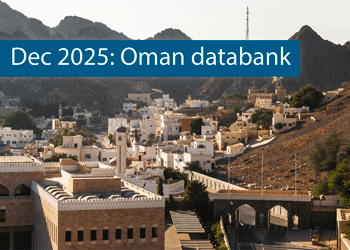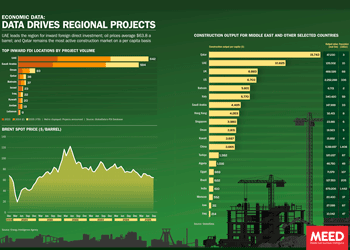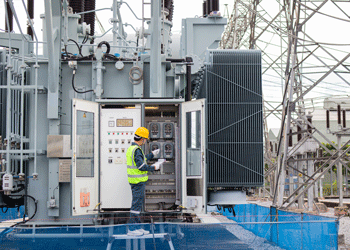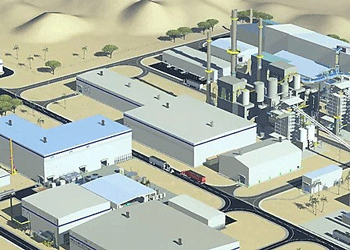Regional stock market listings near record level
23 December 2024

This report also includes: Gulf debt markets make their mark
The Middle East and North Africa (Mena) region’s capital markets got off to a fairly strong start in 2024, with two sizeable listings on the Saudi Stock Exchange (Tadawul) in January. Broadcaster MBC Group’s listing on 8 January raised $222m, while Middle East Pharmaceutical Industries Company (Avalon Pharma) followed up with a $131m share sale on 24 January.
The year ended with a far bigger bang, however, with several multibillion-dollar listings in the UAE and Oman in the final quarter. Among them, grocery chain Lulu Group International raised $1.7bn on the Abu Dhabi Securities Exchange (ADX) in early November. The following month, food delivery and quick commerce business Talabat Middle East raised $2bn when it launched on the Dubai Financial Market (DFM).
 Between those bookends to the year there were dozens of other initial public offerings (IPOs) on the region’s stock markets. According to data compiled by EY, there were 29 new listings in the opening nine months of the year, the same as in the equivalent period of 2023 and only just behind the 31 IPOs in 2022.
Between those bookends to the year there were dozens of other initial public offerings (IPOs) on the region’s stock markets. According to data compiled by EY, there were 29 new listings in the opening nine months of the year, the same as in the equivalent period of 2023 and only just behind the 31 IPOs in 2022.
The final quarter of the year has been the busiest. MEED’s analysis points to the tally reaching 49 IPOs as of mid-December, with several more listings still on the cards for the closing weeks of the year. As such, the previous record for the most IPOs in the region in a year – the 51 seen in 2022 – could well be surpassed.
As has been the case for many years, the GCC bourses have been the dominant focus of activity, with Saudi Arabia hosting 13 IPOs on the main Tadawul market and 24 on the smaller Nomu bourse.
The UAE has had a further seven, with four on the ADX and three on the DFM, while the Kuwait and Muscat exchanges have had one apiece.
Beyond the Gulf, activity has been more limited, but some markets that were dormant for several years have reawakened. There have been two IPOs in Egypt – Act Financial and United Bank of Egypt – and one on the Algiers Stock Exchange, where Credit Populaire d’Algerie’s listing in March was the first in eight years.
Fluctuating activity
IPO activity has ebbed and flowed through the year. According to EY, there were 10 IPOs in the first quarter, the same as in the equivalent period the year before, although this did not include the Algiers listing.
Saudi Arabia saw nine listings in Q1 2024, raising a combined $724m, the most significant being Modern Mills, which raised $314m. That was overshadowed by Parkin Company, however, which raised $429m by listing on the DFM.
In the second quarter, a further 14 companies came to market, raising $2.6bn between them. This was slightly up on the 13 IPOs in Q2 2023 and the proceeds were also up 45%.
Of the total, 11 were in Saudi Arabia, with five on the Tadawul and six on the Nomu. The biggest was Dr Soliman Abdul Kader Fakeeh Hospital Company at $764m, followed by Alef Education Consultancy on the ADX at $515m.
Notably, Kuwait Boursa saw its first listing in two years, with Beyout Investment Group coming to the market in June. The only other IPO outside Saudi Arabia was retailer Spinneys, which listed on the DFM, raising $375m.
Activity slowed in the third quarter, with just five new listings, which raised $930m between them. Almost all of this was accounted for by the listing of NMDC Energy on the ADX, which involved a raise of $877m – the largest of the year at the time, although that figure was overtaken several times in the final quarter.
Saudi Arabia saw three more listings on the Nomu market in Q3, raising $27m in total. During this period, Act Financial also made its market debut, becoming the first new listing on Egyptian Exchange (EGX) in two years.
At the end of Q3, EY estimated that a further 11 companies were planning to list on exchanges in the Mena region before the year was out.
Not all of these listings have gone ahead, but a number of major IPOs have been completed, including OQ Exploration & Production on the Muscat Stock Exchange (MSX), which raised $2bn on 28 October. It was followed by the IPOs of hypermarket chain Lulu Group and food delivery operator Talabat over the next two months.
In addition, there have been five more listings on the Tadawul, including Al-Majed Oud Company and Arabian Mills for Food Products Company, and nine more on the Nomu market.
Other deals have been announced but have so far yet to be completed. These included Oman’s OQ Base Industries, which in November announced plans to sell up to 49% of its shares and seek a listing on the MSX by mid-December.
The huge listings in the fourth quarter of 2024 mean that the downward trajectory of 2023 has been turned around, even if the heights of 2022’s fundraisings have not quite been matched.
After the $22bn raised in 2022, the total fell to $10.7bn in 2023. In 2024, the total reached about $12.5bn by 10 December, including $8bn raised in the final quarter.

Diverging indices
The wider market performance of regional bourses has been decidedly mixed in 2024.
There have been a handful of standout performers across the region. The Moroccan All Shares Index (MASI), for example, was up 22.7% between January and the end of November, with Egypt’s EGX 30 Index not far behind at 21.5%, according to data compiled by Kuwait’s Kamco Invest.
In the Gulf region, Dubai’s DFM General Index was up 19.4% over the same period, while Tunisia’s TunIndex also saw a creditable 12.7% gain.
In contrast, Riyadh’s Tadawul All-Share Index (Tasi), the FTSE ADX General Index, Qatar’s QE20 Index and Jordan’s ASE Index all saw their values fall in the first 11 months, with drops of between 1% and 4%.
Other major bourses saw more limited gains, with the Kuwait All Share Index posting a rise of 6.3%, while the Bahrain All Share Index was up 3.1% and Oman’s MGX 30 Index gained just 1.1%.
It is hard to see any clear pattern in these results. To date, five regional bourses have posted a better overall performance in 2024, compared to 2023, but six are faring worse.
This fits in with the mixed performances seen on the global level. The MSCI World Index gained more than 20% in the first 11 months of the year, helped by a strong performance in the US, where the S&P 500 rose by 26.5%. In contrast, the MSCI Emerging Markets Index was up just 5.4% over the same period.
The buoyant market for regional IPOs suggests that many companies and investors feel relatively optimistic, however.
A second IPO is due to take place in Algeria before the end of the year, with the listing of Banque de Developpement Local, and more are pencilled in for 2025.
In neighbouring Morocco, irrigation specialist CMGP Group is also aiming for a $110m IPO on the Casablanca Stock Exchange in the near future.
However, Gulf markets are likely to continue to dominate in the near future. At least four more listings are planned in Saudi Arabia in the closing weeks of 2024 and the start of 2025, and many more are sure to follow.
Main image: Food delivery business Talabat raised $2bn with its IPO on the Dubai Financial Market in December. Credit: WAM
Exclusive from Meed
-
 Oman’s growth forecast points upwards
Oman’s growth forecast points upwards24 December 2025
-
 December 2025: Data drives regional projects
December 2025: Data drives regional projects23 December 2025
-
 Local firm bids lowest for Kuwait substation deal
Local firm bids lowest for Kuwait substation deal22 December 2025
-
 Saudi-Dutch JV awards ‘supercentre’ metals reclamation project
Saudi-Dutch JV awards ‘supercentre’ metals reclamation project22 December 2025
-
 QatarEnergy LNG awards $4bn gas project package
QatarEnergy LNG awards $4bn gas project package22 December 2025
All of this is only 1% of what MEED.com has to offer
Subscribe now and unlock all the 153,671 articles on MEED.com
- All the latest news, data, and market intelligence across MENA at your fingerprints
- First-hand updates and inside information on projects, clients and competitors that matter to you
- 20 years' archive of information, data, and news for you to access at your convenience
- Strategize to succeed and minimise risks with timely analysis of current and future market trends

Related Articles
-
 Oman’s growth forecast points upwards
Oman’s growth forecast points upwards24 December 2025

MEED’s January 2026 report on Oman includes:
> COMMENT: Oman steadies growth with strategic restraint
> GVT & ECONOMY: Oman pursues diversification amid regional concerns
> BANKING: Oman banks feel impact of stronger economy
> OIL & GAS: LNG goals galvanise Oman’s oil and gas sector
> POWER & WATER: Oman prepares for a wave of IPP awards
> CONSTRUCTION: Momentum builds in construction sectorTo see previous issues of MEED Business Review, please click herehttps://image.digitalinsightresearch.in/uploads/NewsArticle/15306449/main.gif -
 December 2025: Data drives regional projects
December 2025: Data drives regional projects23 December 2025
Click here to download the PDF
Includes: Top inward FDI locations by project volume | Brent spot price | Construction output
MEED’s January 2026 report on Oman includes:
> COMMENT: Oman steadies growth with strategic restraint
> ECONOMY: Oman pursues diversification amid regional concerns
> BANKING: Oman banks feel impact of stronger economy
> OIL & GAS: LNG goals galvanise Oman’s oil and gas sector
> POWER & WATER: Oman prepares for a wave of IPP awards
> CONSTRUCTION: Momentum builds in construction sectorTo see previous issues of MEED Business Review, please click herehttps://image.digitalinsightresearch.in/uploads/NewsArticle/15306140/main.gif -
 Local firm bids lowest for Kuwait substation deal
Local firm bids lowest for Kuwait substation deal22 December 2025
The local Al-Ahleia Switchgear Company has submitted the lowest price of KD33.9m ($110.3m) for a contract to build a 400/132/11 kV substation at the South Surra township for Kuwait’s Public Authority for Housing Welfare (PAHW).
The bid was marginally lower than the two other offers of KD35.1m and KD35.5m submitted respectively by Saudi Arabia’s National Contracting Company (NCC) and India’s Larsen & Toubro.
PAHW is expected to take about three months to evaluate the prices before selecting the successful contractor.
The project is one of several transmission and distribution projects either out to bid or recently awarded by Kuwait’s main affordable housing client.
This year alone, it has awarded two contracts worth more than $100m for cable works at its 1Z, 2Z, 3Z and 4Z 400kV substations at Al-Istiqlal City, and two deals totalling just under $280m for the construction of seven 132/11kV substations in the same township.
Most recently, it has tendered two contracts to build seven 132/11kV main substations at its affordable housing project, west of Kuwait City. The bid deadline for the two deals covering the MS-01 through to MS-08 substations is 8 January.
https://image.digitalinsightresearch.in/uploads/NewsArticle/15305745/main.gif -
 Saudi-Dutch JV awards ‘supercentre’ metals reclamation project
Saudi-Dutch JV awards ‘supercentre’ metals reclamation project22 December 2025
The local Advanced Circular Materials Company (ACMC), a joint venture of the Netherlands-based Shell & AMG Recycling BV (SARBV) and local firm United Company for Industry (UCI), has awarded the engineering, procurement and construction (EPC) contract for the first phase of its $500m-plus metals reclamation complex in Jubail.
The contract, estimated to be worth in excess of $200m, was won by China TianChen Engineering Corporation (TCC), a subsidiary of China National Chemical Engineering Company (CNCEC), following the issue of the tender in July 2024.
Under the terms of the deal, TCC will process gasification ash generated at Saudi Aramco’s Jizan refining complex on the Red Sea coast to produce battery-grade vanadium oxide and vanadium electrolyte for vanadium redox flow batteries. AMG will provide the licensed technology required for the production process.
The works are the first of four planned phases at the catalyst and gasification ash recycling ‘Supercentre’, which is located at the PlasChem Park in Jubail Industrial City 2 alongside the Sadara integrated refining and petrochemical complex.
Phase 2 will expand the facility to process spent catalysts from heavy oil upgrading facilities to produce ferrovanadium for the steel industry and/or additional battery-grade vanadium oxide.
Phase 3 involves installing a manufacturing facility for residue-upgrading catalysts.
In the fourth phase, a vanadium electrolyte production plant will be developed.
The developers expect a total reduction of 3.6 million metric tonnes of carbon dioxide emissions a year when the four phases of the project are commissioned.
SARBV first announced its intention to build a metal reclamation and catalyst manufacturing facility in Saudi Arabia in November 2019. The kingdom’s Ministry of Investment, then known as the Saudi Arabian General Investment Authority (Sagia), supported the project.
In July 2022, SARBV and UCI signed the agreement to formalise their joint venture and build the proposed facility.
The project has received support from Saudi Aramco’s Namaat industrial investment programme. Aramco, at the time, also signed an agreement with the joint venture to offtake vanadium-bearing gasification ash from its Jizan refining complex.
Photo credit: SARBV
https://image.digitalinsightresearch.in/uploads/NewsArticle/15305326/main.gif -
 QatarEnergy LNG awards $4bn gas project package
QatarEnergy LNG awards $4bn gas project package22 December 2025
QatarEnergy LNG, a subsidiary of state-owned QatarEnergy, has awarded the main engineering, procurement, construction and installation (EPCI) contract for a major package for the second phase of its North Field Production Sustainability (NFPS) project.A consortium comprising the Italian contractor Saipem and state-owned China Offshore Oil Engineering Company (COOEC) has secured the EPCI contract for the COMP5 package. The contract value is $4bn, with Saipem declaring its share to be worth $3.1bn.
Milan-headquartered Saipem said the contract will run for about five years. The scope of work comprises engineering, procurement, fabrication and installation of two compression complexes, each including a compression platform, a living quarters platform, a flare platform supporting the gas combustion system, and the related interconnecting bridges. Each complex will have a total weight of about 68,000 tonnes.
Offshore installation operations will be carried out by Saipem’s De He construction vessel in 2029 and 2030.
MEED previously reported that the following contractors submitted bids for the NFPS phase two COMP5 package:
- Larsen & Toubro Energy Hydrocarbon (India)
- McDermott (US)
- Saipem/China Offshore Oil Engineering Company (Italy/China)
QatarEnergy LNG, formerly Qatargas, is said to have issued the tender for the NFPS phase two COMP5 package in the first quarter of the year.
Contractors submitted technical bids for the COMP5 package in late June, while commercial bids were submitted by 8 October, as per sources.
Based upon initial evaluation of bids by QatarEnergy LNG, L&TEH has emerged as the lowest bidder for the COMP5 package, followed by McDermott, with the consortium of Saipem and COOEC in third place, MEED reported in late October.
In the weeks following that, the project operator is said to have engaged all bidders for a final round of negotiations, during which the consortium of Saipem and COOEC is believed to have “clinched the deal”, according to sources.
The detailed scope of work on the COMP5 package covers the EPCI work on the following:
- Two gas compression platforms, each weighing 30,000-35,000 tonnes, plus jacket
- Two living quarters platforms, plus jacket
- Two gas flare platforms, plus jacket
- Brownfield modification work at two complexes
NFPS scheme
QatarEnergy’s North Field liquefied natural gas (LNG) expansion programme requires the state enterprise to pump large volumes of gas from the North Field offshore reserve to feed the three phases of the estimated $40bn-plus programme.
QatarEnergy has already invested billions of dollars in engineering, procurement and construction works on the two phases of the NFPS project, which aims to maintain steady gas feedstock for the North Field LNG expansion phases.
The second NFPS phase will mainly involve building gas compression facilities to sustain and gradually increase gas production from Qatar’s offshore North Field gas reserve over the long term.
Saipem has been the most successful contractor on the second NFPS phase, securing work worth a total of $8.5bn.
QatarEnergy LNG awarded Saipem a $4.5bn order in October 2022 to build and install gas compression facilities. The main scope of work on the package, which is known as EPCI 2, covers two large gas compression complexes that will comprise decks, jackets, topsides, interconnecting bridges, flare platforms, living quarters and interface modules.
The gas compression complexes – CP65 and CP75 – will weigh 62,000 tonnes and 63,000 tonnes, respectively, and will be the largest fixed steel jacket compression platforms ever built.
Following that, Saipem won combined packages COMP3A and COMP3B of the NFPS project’s second phase in September last year.
The scope of work on the combined packages encompasses the EPCI of a total of six platforms, approximately 100 kilometres (km) of corrosion resistance alloy rigid subsea pipelines of 28-inches and 24-inches diameter, 100km of subsea composite cables, 150km of fibre optic cables and several other subsea units.
Separately, QatarEnergy LNG awarded McDermott the contract for the NFPS second phase package known as EPCI 1, or COMP1, in July 2023. The scope of work on the estimated $1bn-plus contract is to install a subsea gas pipeline network at the North Field gas development.
In March this year, India’s Larsen & Toubro Energy Hydrocarbon (LTEH) won the main contract for the combined 4A and 4B package, which is the fourth package of the second phase of the NFPS project and is estimated to be valued at $4bn-$5bn.
The main scope of work on the package is the EPCI of two large gas compression systems that will be known as CP8S and CP4N, each weighing 25,000-35,000 tonnes. The contract scope also includes compression platforms, flare gas platforms and other associated structures.
LTHE sub-contracted detailed engineering and design works on the combined 4A and 4B package to French contractor Technip Energies.
NFPS first phase
Saipem is also executing the EPCI works on the entire first phase of the NFPS project, which consists of two main packages.
Through the first phase of the NFPS scheme, QatarEnergy LNG aims to increase the early gas field production capacity of the North Field offshore development to 110 million tonnes a year.
QatarEnergy LNG awarded Saipem the contract for the EPCI package in February 2021. The package is the larger of the two NFPS phase one packages and has a value of $1.7bn.
Saipem’s scope of work on the EPCI package encompasses building several offshore facilities for extracting and transporting natural gas, including platforms, supporting and connecting structures, subsea cables and anti-corrosion internally clad pipelines.
The scope of work also includes decommissioning a pipeline and other significant modifications to existing offshore facilities.
In addition, in April 2021, QatarEnergy LNG awarded Saipem two options for additional work within the EPCI package, worth about $350m.
QatarEnergy LNG awarded Saipem the second package of the NFPS phase one project, estimated to be worth $1bn, in March 2021.
Saipem’s scope of work on the package, which is known as EPCL, mainly covers installing three offshore export trunklines running almost 300km from their respective offshore platforms to the QatarEnergy LNG north and south plants located in Ras Laffan Industrial City.
Saipem performed the front-end engineering and design work on the main production package of the first phase of the NFPS as part of a $20m contract that it was awarded in January 2019. This provided a competitive advantage to the Italian contractor in its bid to win the package.
https://image.digitalinsightresearch.in/uploads/NewsArticle/15305330/main2239.jpg

